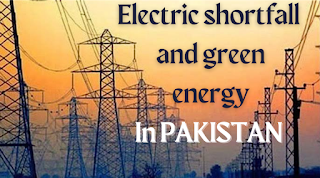Electric shortfall & green energy
The majority of electricity in Pakistan is produced through thermal power plants that run on fossil fuels like oil and gas. The cost of electricity generation through these plants is high due to the fluctuating cost of fuel, which is affected by global oil prices. Additionally, these plants emit greenhouse gases that contribute to climate change, which has a negative impact on the environment and human health. The high cost of fuel-based electricity generation makes it unaffordable for many households in Pakistan, leading to a rise in the use of traditional, polluting fuels like wood and coal.
Cost Savings with Renewable Energy
Renewable energy sources like wind and solar power offer a promising alternative to fuel-based electricity generation. The cost of renewable energy has been decreasing rapidly in recent years, making it more affordable and competitive with fossil fuels. For instance, the cost of solar energy has fallen by 90% since 2009, while the cost of wind energy has fallen by 70%. According to a report by the International Renewable Energy Agency, the cost of renewable energy is now lower than the cost of fossil fuels in many parts of the world.
Pakistan has a significant potential to generate green energy. The country is blessed with abundant renewable energy resources, including solar, wind, hydro, and biomass. According to estimates by the Pakistan Council of Renewable Energy Technologies (PCRET), the total potential for renewable energy in Pakistan is around 60,000 MW.
Solar energy is one of the most abundant renewable resources in Pakistan, with around 8 to 9 hours of sunshine per day on average throughout the year. The country has the potential to generate over 2.9 million megawatts of solar power, which is much higher than its current energy demand.
Similarly, Pakistan has a potential of producing over 50,000 MW of wind energy, mainly in the coastal areas of Sindh and Balochistan provinces. The country has already established several wind power projects in these areas.
Moreover, Pakistan has the potential to generate hydropower from its vast network of rivers, including the Indus, Jhelum, Chenab, and Kabul rivers. The country has already developed several large hydropower projects, including the Tarbela Dam and the Mangla Dam.
Biomass is another potential source of renewable energy in Pakistan, with the potential to generate energy from agricultural waste, municipal waste, and animal waste.
Despite the vast potential of renewable energy in Pakistan, the country still heavily relies on fossil fuels, particularly on imported oil and gas. However, the government has taken several initiatives in recent years to promote renewable energy, including the development of policy frameworks and financial incentives for renewable energy projects. With continued efforts, Pakistan has the potential to become a leader in green energy in the region.
Many countries around the world are already harnessing the potential of renewable energy sources. Here are a few examples:
Germany: Germany is a leader in renewable energy production, with wind and solar energy contributing to more than 40% of the country's electricity production. The country has set a target of achieving 65% renewable energy by 2030.
China: China is the largest producer of renewable energy in the world, with wind and solar energy accounting for about 9% of the country's electricity production. The country has set a target of achieving 20% renewable energy by 2025.
Costa Rica: Costa Rica has achieved 98% renewable energy production, with hydropower, wind, and solar energy contributing to the majority of the country's electricity production. The country has set a target of achieving 100% renewable energy by 2021.
Pakistan's energy sector is in dire need of reform. Corruption in the government energy sector has led to inefficiencies and high costs of production, resulting in frequent power outages and unaffordable electricity for many households. Renewable energy sources like wind and solar power offer a promising alternative, with the potential for significant cost savings and a cleaner environment. By investing in renewable energy and implementing anti-corruption measures in the government energy sector, Pakistan can overcome its energy crisis and achieve a sustainable, prosperous future.

Comments
Post a Comment